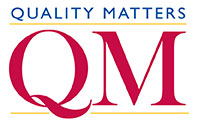Hawkeye offers several courses each semester over the Internet. Most courses run during a regular semester timeframe. It is possible to earn an Associate in Arts degree entirely online via distance learning. Enrollment procedures, credits, and other prerequisites are the same for distance learning courses as they are for face-to-face courses.
All Distance Learning courses require motivation, self-determination, and an investment in time. See the resources available for distance learning students to self-assess their ability to succeed in an online course. Also, all online courses provide a link to Student Resources to help students succeed in their course.
Online/Hybrid Standards
 Hawkeye Community College is a Quality Matters (QM) subscriber institution. Quality Matters provides a nationally recognized, faculty-centered, peer review process for continuous improvement in the design of online and hybrid courses based on eight general course design standards:
Hawkeye Community College is a Quality Matters (QM) subscriber institution. Quality Matters provides a nationally recognized, faculty-centered, peer review process for continuous improvement in the design of online and hybrid courses based on eight general course design standards:
- Course Overview and Introduction
- Learning Objectives (Competencies)
- Assessment and Measurement
- Instructional Materials
- Course Activities and Learner Interaction
- Course Technology
- Learner Support
- Accessibility and Usability
In January 2015, the Course Standards Committee adopted the Quality Matters Rubric, and the Quality Matters framework guides quality assurance and professional development efforts for online learning at Hawkeye.
Hawkeye faculty and staff may access the rubric and additional information in My Hawkeye > Departments > Brobst Center for Teaching and Learning Services > Quality Matters.
Teaching Online
For even the most experienced classroom teacher, teaching online requires a thoughtful transition to this fairly new environment. It is not merely a case of putting a course online, but rather of understanding both the opportunities and limitations of the online learning environment.
Best Practices for Online Teaching
Use the following best practices in online learning to help you get started developing a course that is focused on knowledge creation, rather than knowledge transmission. Online courses are rich with opportunities to create learning-centered environments—be creative!
Develop an effective syllabus
Hawkeye utilizes a syllabus template to ensure consistency of information and presentation to students. Instructors should download the syllabus template for their course from CurricUNET. The template will include specific course information such as the course description and student learning outcomes. Other sections can be customized by the instructor for the specific section they teach.
Define clear course goals and student learning outcomes.
Course goals and learning outcomes are included in the syllabus template, but you should reiterate the learning goals throughout the course.
Recognize differences in student learning styles
Apply that knowledge to your teaching and course materials.
Apply common web design principles to all course materials
- Keep page lengths short. It is usually recommended that a web page length does not exceed two or three screens worth of information. In order to keep your pages short, longer topics can be subdivided into logical chunks of information on separate pages. An individual page should include only relevant, yet complete, information on a single topic.
- Use consistent text fonts and styles.
- Try to stick with one font throughout your entire course site and try to use the same size font, as well.
- Use color appropriately. Color should be used sparingly and only to show key elements of a page or to indicate specific functions like links to other pages or to websites. Black is traditionally used for the main body of text because of its legibility on a light background.
- Keep graphics small. Graphics can be used effectively to add interest to a web page, but the amount and size of graphics should be kept to a minimum. Too many graphics, or a single large graphic, can take a long time to download. Usually, using several smaller graphics, as opposed to one large one, can create a better impression for visitors to your site.
- Write for the web. Unless the intent of your website is to carry a catalog of long technical articles, you will want to make sure your content is short and to the point. People scan for information on the web, use spaces, headings, and bullets to organize your text. This makes it much easier to read and to jump to important information.
Use the Seven Principles of Good Practice in Undergraduate Education.
The Seven Principles of Good Practice in Undergraduate Education principles apply to distance learning courses too!
- Encourage contact between students and faculty.
- Develop reciprocity and cooperation among students.
- Encourage active learning.
- Give prompt feedback.
- Emphasize time on task.
- Communicate high expectations.
- Respect diverse talents and ways of learning.